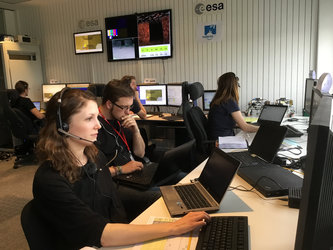SKeyP
SOHO Keyhole Planner
The Solar and Heliospheric Observatory (SOHO)'s mission operations team has had to deal with the 'keyhole periods' problem since 2003, due to a spacecraft malfunction. Four times a year, SOHO faces the so-called 'keyhole periods', two- to four-week periods during which down-linking of telemetry is limited due to a late mission issue with the spacecraft's High-Gain Antenna (HGA). The problem arises from the conflict between limited telemetry down-link capabilities in the keyhole periods, and the need to maximise the return of science data while respecting other constraints, such as limited on-board storage capacity. The SOHO Keyhole Planner (SKeyP) is a software tool designed to improve on the manual work-flow for plan generation by shortening the time needed and reducing the significance of the learning curve associated with this process.
Keywords: artificial intelligence, scheduling, constraint programming
Results
SKEYP has been successfully integrated in the keyhole planning process since May 2009.
Technology
Developed in Java, SKeyP is based on advanced planning and scheduling techniques like constraint programming.
Development Team
SKeyP was developed internally by the Advanced Mission Concepts and Technologies Office together with representative of the SOHO mission operation team.
Description

The Solar and Heliospheric Observatory (SOHO) is a joint ESA/NASA mission to observe the Sun and the solar wind.
SOHO's payload comprises 12 scientific instruments, most of which are still operating, despite the mission having exceeded its 2-year lifetime by more than a decade. Four times a year, SOHO faces the so called 'keyhole periods', two- to four-week periods during which down-linking of telemetry is limited due to a late mission issue with the spacecraft’s High-Gain Antenna (HGA).
Originally, SOHO's HGA - with its two degrees of freedom - was able to continually point toward the Earth and the Deep Space Network’s (DSN) receiving antennas throughout the halo orbit, providing a high data-rate telemetry capability. In 2003, however, HGA mechanism problems arose, eventually leading to the decision to abandon moving it along one of its two degrees of freedom. Together with the requirement to keep the spacecraft oriented toward the Sun, this resulted in two portions of the orbit during which the HGA, with only one remaining degree of freedom, can no longer be turned to an attitude where it would ”see” the Earth and provide high-rate telemetry. These portions constitute the keyhole periods and occur twice per orbit, roughly every 3 months.
During communication gaps, instrument data is stored in SOHO’s on-board recorders, the Solid-State Recorder (SSR; capacity of 2 Gb, random access) and the Tape Recorder (TR; 1 Gb capacity, sequential access). Since these recorders' storage capacities are limited, and high-rate telemetry is required to dump them, there is a high risk of science data loss during keyhole periods.
To address this problem, the so-called SSR Intermittent Recording Patch was developed. This patch enables the selective recording of subsets of instruments on the SSR, thus allowing for the prioritisation of stored data. We should note that, even with this patch, instruments do not stop data production; instead, only the selected subset's data is stored on the SSR, while all other data is lost. Although not ideal, this allows for more control over what is saved, and makes it possible to continuously save all the data generated by the highest priority instruments.

SKeyP is a further proof that AI-based systems may become an invaluable help to mission planning in the future, both in terms of costs and quality of science data produced.
A very satisfying result is the tool's performance. Previous approaches took around one day for an experienced planner to manually generate one plan. SKeyP shows a very high performance in finding a solution, taking seconds to produce a plan - the solution approach is in fact based on a Max-Flow approach which has low polynomial cost, in the order of O(n³). This allows for the possibility of using SKeyP for the rapid production of a set of pre-optimised skeleton plans. These plans may then be evaluated and fine-tuned by the human planner, based on his operational experience. Since the planning process is configurable and very high performance, SKeyP also allows for what-if analysis and comparison of several different solutions, enabling the user to choose which one better adapts to each keyhole period.
Publications
- N. Policella, H. Oliveira, A. Donati, and T. Siili.SOHO's Keyhole Periods Problem: Definition and a Solving Model.In Proceedings of the European Air and Space Conference, CEAS 2009, Manchester, UK, 26-29 October, 2009
- Nicola Policella, Henrique Oliveira, and Tero Siili.SKEYP: AI Applied to SOHO Keyhole Operations.In Third IEEE International Conference on Space Mission Challenges for Information Technology, 2009. SMC-IT 2009, Pasadena, USA, 19-23 July, 2009
- Policella, N., Oliveira, H, and Siili T.Managing SOHO's Keyhole Periods: Problem Definition and Solving Model.In Proceedings of the 6th International Workshop on Planning and Scheduling for Space, IWPSS-09, 2009















 Germany
Germany
 Austria
Austria
 Belgium
Belgium
 Denmark
Denmark
 Spain
Spain
 Estonia
Estonia
 Finland
Finland
 France
France
 Greece
Greece
 Hungary
Hungary
 Ireland
Ireland
 Italy
Italy
 Luxembourg
Luxembourg
 Norway
Norway
 The Netherlands
The Netherlands
 Poland
Poland
 Portugal
Portugal
 Czechia
Czechia
 Romania
Romania
 United Kingdom
United Kingdom
 Slovenia
Slovenia
 Sweden
Sweden
 Switzerland
Switzerland
































